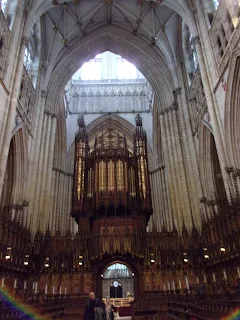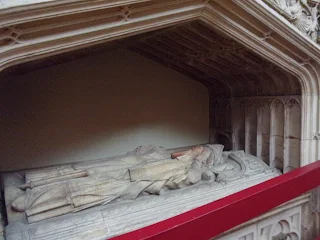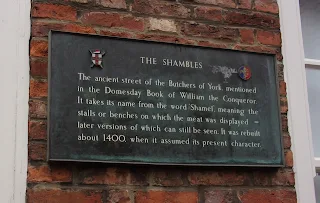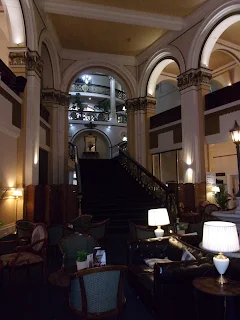York was founded in 71 AD and became capital of the Roman province of Britannia Inferior (although archeological evidence suggests that between 8000 and 7000 BC Mesolithic people settled in the region.) The city was conquered in 866 AD by the Danish army and given the Old Norse name Jórvik. The name gradually reduced to York after the Norman Conquest, with the first recording of the name being in the 13th century.
In the Middle Ages the city grew as a wool trading centre and became northern England's ecclesiastical province's centre (of two nationwide which make up the Church of England; the other being Canterbury in the south.) In the 19th century it became a major confectionery manufacturing centre, and nowadays it's a conservation area, with a historic core that makes it one of the UK's most major tourist destinations.
I last set eyes on York Minster as a little kid, when my parents took me on a day trip to York from Butlin's Filey, where we were staying for the week. I don't remember going in, but I do remember seeing the outside and the nearby Shambles (streets mentioned in the Domesday Book of William the Conqueror.) This time I did go inside this stunning building, which is one of the world's largest Gothic cathedrals.
There has been a church on this site since around 627 AD. King Edwin of Northumbria was baptised here.
This is the south (side) view.
This was replced by a stone version which was destroyed when William the Conqueror's forces carried out the "Harrying of the North" in 1069.
The Rose Window in the South Transept (possibly my favorite feature of the cathedral.)
Between 1080 and 1100 the Archbishop of York, Thomas Bayeux built a new cross-shaped church (situated on a flood plain, which may have contributed to future instability) which was rebuilt above ground level during the Middle Ages.
This is the West Front view.
We were crazy enough to climb the 275 steps to the top of the Central Tower! Here we are at the halfway point, and the Great West Towers house the cathedral's 56 bells.
Reaching the top, and the view of the towers from above. The bell named Great Peter strikes the hour.
Overlooking York, and the Central Tower was originally intended to house the bells.
The climb is certainly worth it, but I wouldn't rush back to do it!
The oldest part we can see nowadays is the South Transept, and building began in 1225. It is possible that the Archbishop of York at that time- Walter de Gray- wanted to build a cathedral bigger and grander than Canterbury Cathedral.
The building is magnificent- don't leave York without giving it a visit, whether you're religious or not.
This is the Great West Window.
In 1967 it became apparent that the tower was sinking under its own weight (due to the aforementioed unstable foundations). But an appeal was launched and stabilising undertaken. The work took five years.
The staircase is spiral, it's a very tight fit, and once you begin climbing there is no going back. You are warned not to do it if you don't feel you can make it!
This door informs you that you're at York's highest point, and the tower is 197 feet/ 60 metres tall.
Back on terra firma, and here we are staring back towards the Great West Door, the ceremonial entrance near the smaller door through which we entered.
Descending, and the cathedral illustrates examples of all three of the phases of English Gothic architecture (1200s, 1300s and 1400s).
This is St Cuthbert's Chapel.
The Rose Window in the South Transept had to be restored using modern techniques after the 1984 fire (caused by lightening; the most recent fire to blight the Minster).
The Pulpitum separates the Nave from the Quire, and is often referred to as the Kings' Screen. I love the cluster ceiling bosses and the fanlight pelmet.
The Quire was once the main area used for worship, and services were only held in the Nave from the 19th century. The fire of 1829, caused by arson by a madman, destroyed a lot of the medieval woodwork. After that, the intermittent Minister Police were made a permanent feature.
The High Altar is the focal point of the Quire, and is both a physical and spiritual high point.
The origins of the Great Organ go back to 1832 (a new organ had to be built following the 1829 attack on the Quire). The Organ's pipes were extensively refurbished between 2018 and 2021.
Heading into the Crypt, and here is "ye olde khazi!"
Donation box...
Eastern Crypt vaulting...
The Doomstone, which is a richly carved representation of Hell. It shows "lost souls being pushed into a cauldron to be burned alive by devils and demons." Nice!
I think this is one of the four piers which supported the original vaulting. They were uncovered following the 1829 fire and date back to the 1160s.
Tomb of Saint William, the Patron Saint of York. He was Archbishop twice, and was thought to have been poisened from a chalice in 1154 whilst saying mass.
The other piers...
I love the swirly mosaic floor in the Western Crypt.
Back upstairs, and traditionally, the Lady Chapel is the largest chapel in a Gothic cathedral, and dedicated to Mary. York Minster's Lady Chapel reredos sits under the Great East window and depicts a colourful nativity scene. It is dedicated to Queen Victoria.
The Great East Window is striking, and was created between 1505-08. It is the largest expanse of medieval stained glass in the country.
The tomb of Tobias Matter, Archbishop of York (1546-1628), in the Lady Chapel.
Sir William Ingram and his wife Catherine are among the great and the good buried buried in York Minster and commemorated by a memorial in the North Quire Aisle.
St Nicholas's Chapel sits in the North Transept.
This two-faced astronomical clock dates back to 1955, and commemorates airmen operting from Yorkshire bases who were killed in action during WWII.
It's considered one of the more stable parts of the Minster and, despite having no central pillar, has survivied for over 700 years.
The architectural formations which keep the ceiling in place can only be seen during a behind-the-scenes tour...
Roman footings, viewed through a state-of-the-art glass floor. They are not parallel with the medieval Minster, which is probably a contributing factor towards its apparent instability.
Archbishop Thomas Savage (died 1507).
St Stephen's Chapel, in the North Quire Aisle.
I particularly like the effective ceramic reredos: The First Hour of The Crucifiction, which dates from 1937.
I've seen figures such as these in old churches before. This is a memorial to Sir Henry Bellasis (1555-1624).
Memorial to Thomas Watson Wentworth.
Row of tombs. Little Miss Macabre would find this section interesting!
The Chapter House was my favourite area of the Minster. It's an octagonal beauty, designed as an assembly room for the Chapter to run day-to-day business.
...But just before you enter you can see a scale model of its structure.
In the Undercroft Museum you can see the thickness of the foundation walls...
The museum is full of interesting historical artefacts, such as this cabinet regarding what has survivied over the centuries. Note that many treasures were destroyed or repurposed during/ after the Reformation.
The low light down here was making me feel drowsy- so I took this final photo of a perspex model of York Minster and skedaddled!
We stopped at the Guy Fawkes Inn for a pint. It's the birthplace of the notorious plotter, who tried to blow up Parliament in 1605; an event that's still marked over 400 years later.
It's for this artisan chocolate shop! I didn't venture in, but it must be good- on one day a queue had formed an hour before opening time, and one lady had even brought a seat with her!
Looking back at the Minster, and this is the view I remember observing as a kid, whilst walking down here with my parents.
We headed into the Shambles, which date from about 1400, and here's a plaque explaining that. The name comes from the Butchers of York, and the word "Shamel" means the stalls or benches used to display the meat.
The area is filled with unique, artisan shops. But what is this queue for?😮
York has a long chocolate tradition and was once known as Chocolate City. Giant confectionery brands Terry's and Rowntree's both hailed from York.
The roofs in the Shambles lean so close together that they almost touch. I have read that it is possible to reach from the upstairs window and shake hands with a person in the building opposite!
This was taken during our rainy first night, and the Shambles look very atmospheric and spooky. They do run ghost tours in the area, but we weren't in the city long enough to be able to fit one in.
I love this city, and have earmarked it as a possible future place of residence!
York, I will return. Until then...
TTFN
The Miss Elaineous
XXXXXXXXXXXXXXXXXXXXXXXXXXXXX
XXXXXXX
X
XXXXXXX
X


















































































